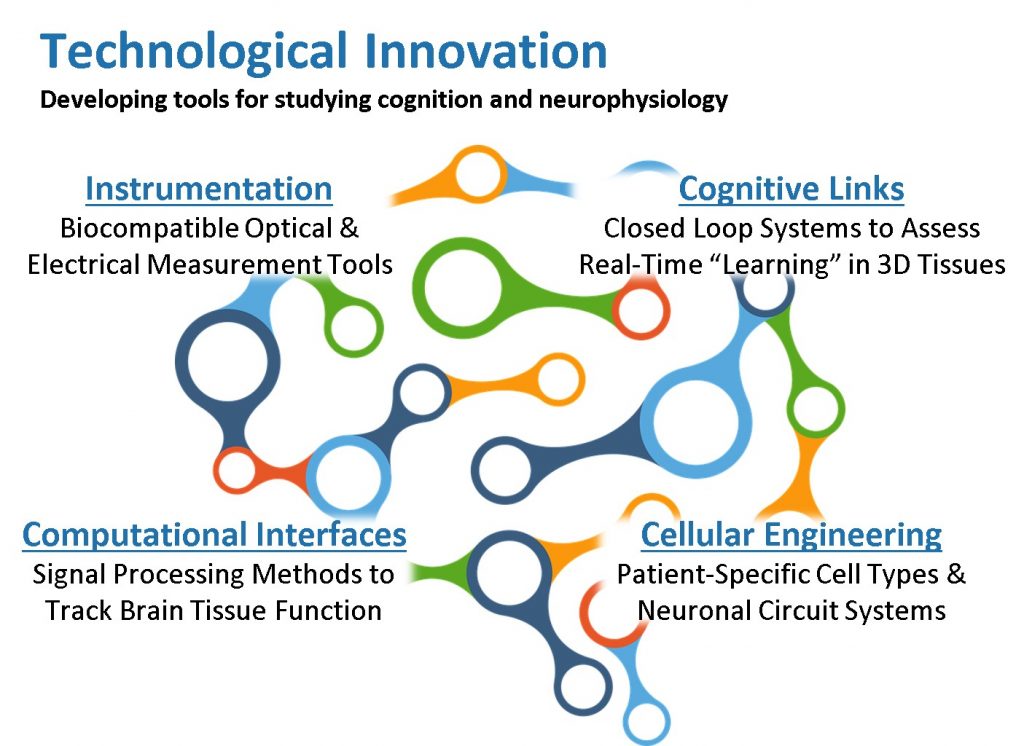Our 3D brain-like tissues will be used not only to elucidate structures and mechanisms underlying function, dysfunction, and regeneration but also to develop new approaches for device integration in brain tissues to improve study, diagnosis, and treatment. Using the combined expertise of INSciDE collaborators, we can develop highly innovative experimental platforms and capabilities that integrate research from molecular mechanism to cognition and to promote multi-disciplinary research and learning at Tufts and beyond.

Ongoing Technological Innovations:
- Imaging and electronic interfaces: Stimulation tools (e.g., optogenetics, multi-electrode arrays) based on analytical models or stochastic approaches to optimize noninvasive readouts of function and/or to stimulate brain function over time.
- Optical and electrical measurement tools: Performing spatiotemporal mapping of neuronal activity in brain and engineered brain tissues with transmembrane voltage sensitive fluorescent dyes. Simultaneous co-local electrical stimulation will examine local stimulus responses in brain and correlate these with spatially distributed responses using optically translucent electrodes. Tools will be developed to resolve brain function mechanisms with co-loaded markers and multispectral optical imaging of membrane potentials, intracellular calcium and other ionic and molecular mediators.
- Computational interfaces: Signal processing and computational neuroscience methods to track, control and understand brain tissue functions (closed-loop interfaces for memory/learning). Development, validation, and translation of a suite of computational models and tools capable of turning sensor data into information across multiple temporal and spatial scales, from intracellular molecular networks to higher levels of abstraction needed to capture complex processes including memory formation and decision making.
- Cognitive links: Develop links between brain functions elucidated in vitro to cognitive readouts in vivo, to establish cause and effect, to predict organism responses and to examine prophylactic and repair treatments. Utilize such links to study pharmacological and behavioral treatments to better predict outcomes, as well as gain basic insight into the storage of memories in living tissues.
- Robotics: Utilize the brain and neural tissue functions for interfaces related to robotics, robust system designs and synthetic bioengineering, integrate brain-like tissue systems into robotic devices, and develop new computational media modeled on bioelectrical networks in non-neural cells.
- Cellular engineering: Studying 3-D brain tissue models based on iPSCs from patients with brain diseases and iPSCs that carry specific disease mutations introduced by CRISPR. Targeted arrangement of these cells using biocompatible scaffolds and tissue engineering principles enable the reconstruction of the architecture, function and heterocellular composition of diseased neural circuits (e.g., cortical – striatal, cortical – dopaminergic networks and the brain – intestine – immune axis). Additional model complexity is achieving using iPSC technology to derive specific neuronal cell types (cortical, striatal, dopaminergic, and enteric nervous cells) and support cells (astrocytes, microglia, and oligodendrocytes).